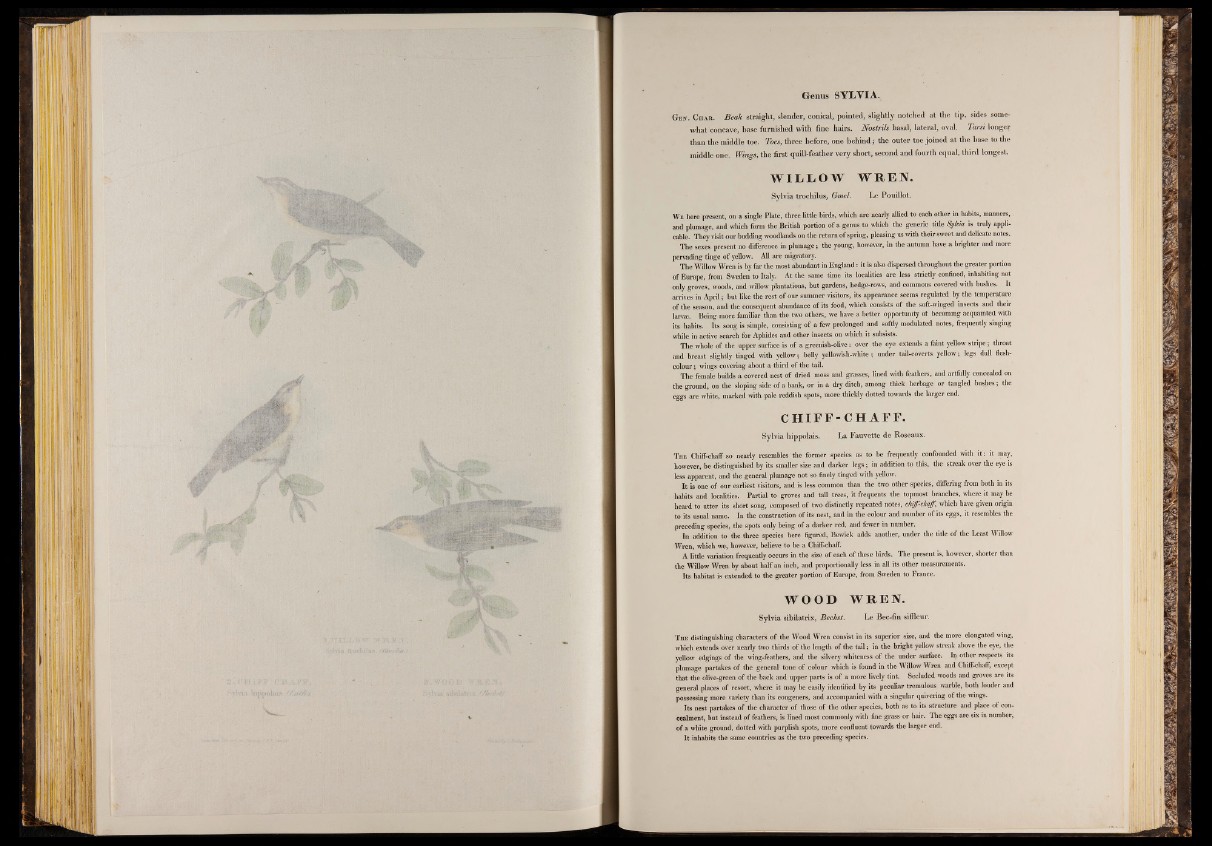
Genus SYLVIA.
Gen. Char. Beak straight, slender, conical, pointed, slightly notched at the tip, sides somewhat
concave, base furnished with fine hairs. Nostrils basal, lateral, oval. Tarsi longer
than the middle toe. Toes, three before, one b eh in d ; the outer toe joined at the base to the
middle one. Wings, the first quill-feather very short, second and fourth equal, third longest.
WI L L OW WREN.
Sylvia trochilus, Gmel. Le Pouillot.
We here present, on a single Plate, three little birds, which are nearly allied to each other in habits, manners,
and plumage, and which form the British portion of a genus to which the generic title Sylvia is truly applicable.
They visit our budding woodlands on the return of spring, pleasing us with their sweet and delicate notes.
The sexes present no difference in plumage; the young, however, in the autumn have a brighter and more
pervading tinge of yellow. All are migratory.
The Willow Wren is by far the most abundant in England: it is also dispersed throughout the greater portion
of Europe, from Sweden to Italy. At the same time its localities are less strictly confined, inhabiting not
only groves, woods, and willow plantations, but gardens, hedge-rows, and commons covered with bushes. It
arrives in April; but like the rest of our summer visitors, its appearance seems regulated by the temperature
of the season, and the consequent abundance of its food, which consists of the soft-winged insects and their
lame. Being more familiar than the two others, we have a better opportunity of becoming acquainted with
its habits. Its song is simple, consisting of a few prolonged and softly modulated notes, frequently singing
while in active search for Aphides and other insects on which it subsists.
The whole of the upper surface is of a greenish-olive: over the eye extends a faint yellow stripe; throat
and breast slightly tinged with yellow; belly yellowish-white; under tail-coverts yellow; legs dull flesh-
colour ; wings covering about a third of the tail.
The female builds a covered nest of dried moss and grasses, lined with feathers, and artfully concealed on
the ground, on the sloping side of a bank, or in a dry ditch, among thick herbage or tangled bushes; the
eggs are white, marked with pale reddish spots, more thickly dotted towards the larger end.
C H I F F -C H A F F .
Sylvia hippolais. La Fauvette de Roseaux.
The Chiff-chaff so nearly resembles the former species as to be frequently confounded with i t : it may,
however, be distinguished by its smaller size and darker legs; in addition to this, the streak over the eye is
less apparent, and the general plumage not so finely tinged with yellow.
It is one of our earliest visitors, and is less common than the two other species, differing from both in its
habits and localities. Partial to groves and tall trees, it frequents the topmost branches, where it may be
heard to utter its short song, composed of two distinctly repeated notes, chiff-chaff, which have given origin
to its usual name. In the construction of its nest, and in the colour and number of its eggs, it resembles the
preceding species, the spots only being of a darker red, and fewer in number.
In addition to the three species here figured, Bewick adds another, under the title of the Least Willow
Wren, which we, however, believe to be a Chiff-chaff.
A little variation frequently occurs in the size of each of these birds. The present is, however, shorter than
the Willow Wren by about half an inch, and proportionally less in all its other measurements.
Its habitat is extended to the greater portion of Europe, from Sweden to France.
WOOD WREN,
Sylvia sibilatrix, Bechst. Le Bec-fin siffleur.
The distinguishing characters of the Wood Wren consist in its superior size, and the more elongated wing,
which extends over nearly two thirds of the length of the tail; in the bright yellow streak above the eye, the
yellow edgings of the wing-feathers, and the silvery whiteness of the under surface. In other respects its
plumage partakes of the general tone of colour which is found in the Willow Wren and Chiff-chaff, except
that the olive-green of the back and upper parts is of a more lively tint. Secluded woods and groves are its
general places of resort, where it may be easily identified by its peculiar tremulous warble, both louder and
possessing more variety than its congeners, and accompanied with a singular quivering of the wings.
Its nest partakes of the character of those of the other species, both as to its structure and place of concealment,
but instead of feathers, is lined most commonly with fine grass or hair. The eggs are six in number,
of a white ground, dotted with purplish spots, more confluent towards the larger end.
It inhabits the same countries as the two preceding species.